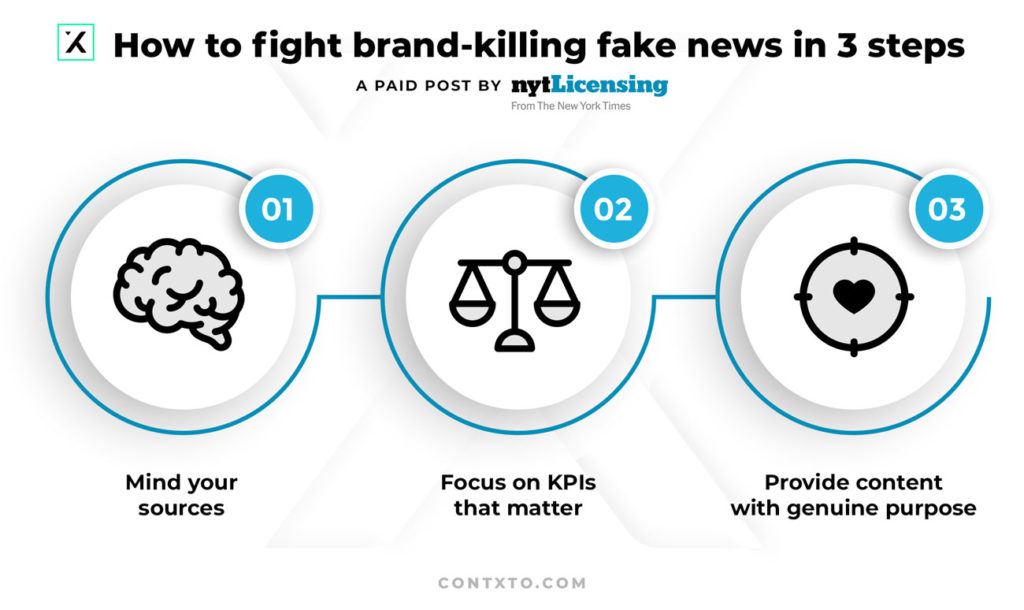
Contxto – “Content is King”. It’s the mantra of those who understand the power of knowledge in an era of misinformation.
The phrase was popularized by Bill Gates in 1996, in an essay published on Microsoft’s website, and it remains surprisingly current. In it, he says:
One of the interesting things about the Internet is that anyone with a PC and a modem can publish any content they can create.
Although the democratization of information production (amplified in the 2000s with the spread of social networks) is beneficial to society, we have been seeing the side effects of this trend for some years.
IT happens: How the Internet powers “fake news”
Like it or not, misinformation (accidentally sharing wrong info) and disinformation (deliberately misleading your audience) are already part of our lives.
You may have come to know it under its actually rather unhelpful alias “fake news”, and it has increased during the Covid-19 pandemic. It can appear as lies, distortion of facts, or simply negligence in conducting research.
And while social media networks like Facebook and Twitter have taken steps to combat misinformation by private and public actors, the volume of publications online makes it nearly impossible to eradicate it completely.
Brands can interact with misinformation directly or indirectly.
The first can be done by producing or disseminating the questionable material (even if unintentionally). Meanwhile, indirect dissemination can happen, for example, by not having control of the ads shown on one’s pages.
This is actually not all that new in spite of the internet’s role in super-charging disinformation dissemination. Historically, to be seen to publish misinformation is the best way to damage the credibility, even the financial wellbeing, of companies.
Why? Because beyond their products, all companies chiefly deal in trust.
Trust: Tough to build, quick to squander
Brands can learn a lot from reputable publishers. Not only that, but publishers can actually be a valuable ally for companies in developing content marketing strategies that incorporate expert content into their initiatives.
Publishers are, by nature, fact-checking institutions on the front line in the battle against misinformation. Many even have content licensing divisions that help brands develop a content marketing offer specifically tailored to their goals and audience profiles.
In producing their content marketing strategies, there are specific steps brands can take—together with publishers—to reduce the impact of misinformation. What for? To nurture a more genuine and effective connection with their customers:

1. Mind your sources
Always look for recognized, authoritative, and expert voices because they will be associated with and will influence your brand image directly.
Nobody creates content out of thin air. Whoever you are and whatever your brand does, you’ll need good information from the wider world. This is actually not as easy as it sounds.
Marketers must make sure to educate everyone involved in the production and distribution of content. It might be your in-house content department, but it could also be a third-party agency or an outside content provider.
Recognizable and reputable publishers can also provide licensed content to complement your marketing offer. By using licensed content, brands not only benefit from established credibility, timely relevance, and experienced storytelling, but it means they can also focus their resources on creating even more original content and other initiatives.
2. Focus on KPIs that matter
In an era where our feeds are assailed with clickbait and low-quality information, brands can assure they are building a true relationship with customers by adopting performance KPIs to measure the effectiveness of content posted online.
For engagement, think comments, shares, likes, scroll depth, time on page and number of sessions. For reputation, think mentions, sentiment analysis and share of voice.
With time, valuing this kind of metric will help shape the culture of the marketing departments to focus on material that adds value to people’s lives, instead of furthering clickbait culture.
Shifting focus to providing value also allows brands to develop deeper connections with influential audiences and high level decision makers.
Working with a high-quality publisher to license content can help marketers develop an engaged group of niche consumers that deliver more return on investment in the long run than a click-rate focused approach.
3. Provide content with genuine purpose
Audiences can sense if the brand’s reason for providing content is genuinely empathetic or if it’s just trying to push its wares. A fact made especially true in the context of the current pandemic, as consumers are faced with increasing uncertainty in their lives. They do not want to be toyed with.
Focus your offering on quality content that will help people navigate through these difficult times and they will remember your brand even when they are not directly interacting with your platforms.
In practical terms, that means answering questions people are asking and providing solutions to problems they are experiencing. As long as they keep that in mind, companies will see an increase in brand affinity and awareness.
This is yet another way that companies can learn from publishers. Over the years, they have been increasingly investing in service journalism; content that focuses on providing readers with helpful advice and practical tips to improve their lives.
Service journalism has become a very important part of publishers’ digital pay model strategies as it provides immense value to their audiences.
The New York Times, for instance, created a series of content dedicated to service journalism, called Smarter Living. It provides readers with helpful advice and guides on a wide-range of topics from personal finance to home decorating.
Most recently, The New York Times has also invested in At Home, a series of articles aimed at helping their readers navigate home-life in the wake of Covid-19.
A helping hand for any brand
Brands that strive to understand the challenges that their customers are facing will always create content that helps them overcome those difficulties.
Conversely, their audiences stand to deepen their brand loyalty and establish deeper relationships with any company that sincerely extends an empathic hand.
Creating this content from scratch can seem overwhelming, but there are resources available to companies who are looking for an assist.
NYTLicensing, the licensing division of The New York Times, can help brands build and bolster their content marketing strategies with curated articles, photos, and videos from The New York Times, as well as other reputable publishing brands.
Do you feel that licensing expert content can help you build trust and credibility with potential customers? Contact The New York Times Licensing Group to learn more about incorporating licensed content into your content marketing strategy.
To learn more about using licensed content within your content marketing strategy, and how it can help increase your ROI, download a free whitepaper: “7 ways Licensed Content Can Help Improve ROI” from The New York Times Licensing Group.
-AG






